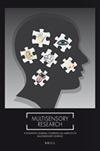与任务无关的亮度调制是否影响听觉对比度处理?探索时间同步性与刺激显著性之间的相互作用
IF 1.5
4区 心理学
Q3 BIOPHYSICS
引用次数: 0
摘要
刺激因素,如时间、空间位置和刺激有效性影响信息是否以及如何跨感官整合。在此基础上,我们研究了视觉信息对听觉加工的影响,补充了以往关于听觉信息对视觉加工影响的研究。我们假设当视觉信息处于最佳显著水平并与声音同步变化时,与任务无关和空间非信息性的视觉信息会增强听觉对比加工。我们要求人类观察者指出调幅白噪声声音的位置,而它在恒定白噪声背景下的响度在不同的试验中有所不同。为了测试与任务无关的视觉信息的影响,我们平滑地(实验1)或瞬时地(实验2)调节屏幕亮度与目标声音的振幅调制相一致或非相一致。此外,为了检验时间同步性和刺激显著性之间的相互作用,最大亮度在不同的试验中有系统地变化。听觉对比阈值在不同条件下进行比较。结果表明,与任务无关的视觉信息不会改变听觉对比度阈值,而不管亮度调制的性质如何,这与我们的预期相反。尽管如此,如果我们考虑到最大多感官效应所需的最佳显著性的个体差异,那么与任务无关的视觉信息与目标声音同步调制会降低听觉对比阈值。我们的结果讨论了几个刺激因素,可能是关键的调节多感官增强。本文章由计算机程序翻译,如有差异,请以英文原文为准。
Does Task-Irrelevant Brightness Modulation Affect Auditory Contrast Processing? Exploring the Interplay Between Temporal Synchrony and Stimulus Salience
Stimulus factors such as timing, spatial location, and stimulus effectiveness affect whether and how information across the senses is integrated. Extending recent work highlighting interactions between stimulus factors, here we investigated the influence of visual information on auditory processing, complementing previous studies on the influence of auditory information on visual processing. We hypothesized that task-irrelevant and spatially non-informative visual information would enhance auditory contrast processing, when visual information was at an optimal salience level and changed synchronously with the sound. We asked human observers to indicate the location of an amplitude-modulated white-noise sound, while its loudness against a constant white-noise background varied across trials. To test for the influence of task-irrelevant visual information, we modulated screen brightness smoothly (Experiment 1) or transiently (Experiment 2) in phase or out of phase with the amplitude modulation of the target sound. In addition, to test for the interaction between temporal synchrony and stimulus salience, maximum brightness varied systematically across trials. Auditory contrast thresholds were compared across conditions. Results showed that task-irrelevant visual information did not alter auditory contrast thresholds regardless of the nature of modulation of brightness, contrary to our expectations. Nonetheless, task-irrelevant visual information modulated in phase with the target sound reduced auditory contrast thresholds if we accounted for individual differences in the optimal salience required for the largest multisensory effects. Our results are discussed in light of several stimulus factors that might be critical in modulating multisensory enhancement.
求助全文
通过发布文献求助,成功后即可免费获取论文全文。
去求助
来源期刊

Multisensory Research
BIOPHYSICS-PSYCHOLOGY
CiteScore
3.50
自引率
12.50%
发文量
15
期刊介绍:
Multisensory Research is an interdisciplinary archival journal covering all aspects of multisensory processing including the control of action, cognition and attention. Research using any approach to increase our understanding of multisensory perceptual, behavioural, neural and computational mechanisms is encouraged. Empirical, neurophysiological, psychophysical, brain imaging, clinical, developmental, mathematical and computational analyses are welcome. Research will also be considered covering multisensory applications such as sensory substitution, crossmodal methods for delivering sensory information or multisensory approaches to robotics and engineering. Short communications and technical notes that draw attention to new developments will be included, as will reviews and commentaries on current issues. Special issues dealing with specific topics will be announced from time to time. Multisensory Research is a continuation of Seeing and Perceiving, and of Spatial Vision.
 求助内容:
求助内容: 应助结果提醒方式:
应助结果提醒方式:


